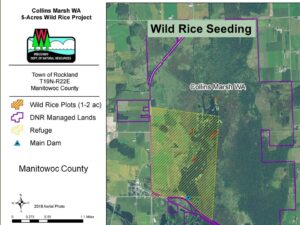 By Peter Ziegler, Project Director – habitat@wisducks.org
By Peter Ziegler, Project Director – habitat@wisducks.org
This article originally appeared in Wisconsin Waterfowl Association’s March, 2022 Newsletter edition.
You may have seen on our facebook page the completion of a couple of projects in the last two weeks. Conditions were ideal for access to these sites, allowing us to knock out a few projects this year. One had been waiting two years for Mother Nature to create enough frost for access. In contrast to last winter, when we had almost no frost, it was welcomed. Contractors also staged some stone for project work in St Croix County, which will be completed soon.
 As we wrapped up our annual meeting this past month I summarized a few points of our habitat program (check out my full year in review here). WWA installed seven water control structures, most of these providing the ability to manage water levels, which ultimately allows for the management of vegetation. Vegetation management is a key to keeping your wetland healthy and attractive for wildlife.
As we wrapped up our annual meeting this past month I summarized a few points of our habitat program (check out my full year in review here). WWA installed seven water control structures, most of these providing the ability to manage water levels, which ultimately allows for the management of vegetation. Vegetation management is a key to keeping your wetland healthy and attractive for wildlife.
In addition, we plugged/filled six ditches, which provide true hydrological restoration through the removal of surface water drains. These types of projects help raise the water in the system and support desired wetland plants, which provide many of the critical needs of wildlife. Many of these systems with functioning ditches are dominated with undesirable plants, which have reduced wildlife benefits. So by reversing the drainage, we are keeping shallow ground water levels more stable and mimicking the natural conditions of how the wetlands historically developed.
 It was a terrible year for wild rice across the upper Midwest, from the drought conditions in northern Minnesota to poor rice production in Wisconsin. WWA did manage to secure 150lbs of rice, which was planted at Collins Marsh as part of trial program. A few sites, in cooperation with WDNR, were selected both in and out of the refuge area with anticipation to establish a wild rice bed for enhanced wildlife benefits.
It was a terrible year for wild rice across the upper Midwest, from the drought conditions in northern Minnesota to poor rice production in Wisconsin. WWA did manage to secure 150lbs of rice, which was planted at Collins Marsh as part of trial program. A few sites, in cooperation with WDNR, were selected both in and out of the refuge area with anticipation to establish a wild rice bed for enhanced wildlife benefits.
Over the next month we should see lots of returning waterfowl and full breeding plumage, so get out and take a look.
